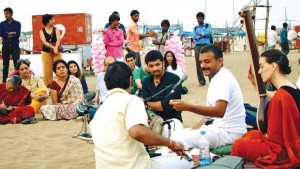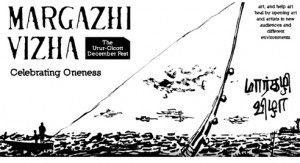Registered with the Registrar of Newspapers for India under R.N.I 53640/91
Vol. XXV No. 17, December 16-31, 2015
A Special feature for the Music Season Is Carnatic music casteist?
by Radhika Rammohan
The author, a student of Carnatic music and a rasika, is a software engineer by training, and a social entrepreneur.
In January this year I enthusiastically attended the Urur-Olcottkuppam Margazhi Vizha as a resident of South Chennai, lay-listener of Carnatic music, and peripheral volunteer at the festival. Changing the context, bringing together people of different backgrounds on the equalising beach sands, and a sense of inclusivity, all appealed to me. I enjoyed the change from the stifling air-conditioned sabha with its Kanchipuram silks, perfumed air, and specific accents, to the simple fishing village playing hosts to us. Village children proudly showed off their villupaattu and, in turn, enjoyed a different sound presented by P. Unnikrishnan. It was a great occasion bringing together fisherfolk, the socially-aware urban crowd, beach-walkers and regular concert-goers.
I did not, however, see this vizha as an answer or challenge to the Brahmin caste’s alleged domination of the art. Yes, most performers today are Brahmins, and so are listeners. However, is this by design of the Brahmins, and are non-Brahmin aspirants feeling hurt and left out? Several articles over the last few months, including some published by reputable Indian and foreign media make out that, over the last few decades, the Brahmin elite of Chennai deliberately elbowed out the nagaswaram community. Many of these articles quote the charismatic vocalist T.K. Krishna or present his interpretation of history. I admire my friend TM’s music and his genuine search for a critical understanding of the relationship between art and society. However, many of the conclusions he draws are flawed.

Let us examine this more in the historical and social-political context of this art.
In the pre-Trinity era, the important composers of the Tamil Nadu are Muthu Tandavar, Marimutha Pillai and Arunachala Kavi, all non-Brahmins. Purandaradasa, considered the ‘father’ of the art form, was from the Vaisya caste. Performers and composers spanning several centuries straddled many classes and at least two castes – Brahmin and Isai Velalar. It is well known that Muthuswami Dikshitar had several non-Brahmin students including the Thanjavur Quartet and Kamalam, a devadasi.
Most occupations, art forms, folk traditions, and craft were practised by specific castes. Every caste perpetuated the traditions they were custodians of, including the tradition of caste itself. Let me hasten to add that this is no attempt to condone inhumane treatment of the so-called lower castes or the crime of untouchability.
* * *

My great-grandfather, Soolamangalam Vaidyanatha Bhagavatar (1866 to 1943), was a respected Brahmin Harikatha Bhagavatar and a towering musical personality of his era. He wrote a series of articles for Kalki magazine – now also published as a book in England titled Cameos (A Collection of Writings on Carnatic Musicians of the late 19th and early 20th centuries) chronicling noteworthy artists he had personally witnessed. Many of the artists he wrote about, in admiring tones, were non-Brahmins (Pillais). A great deal of cooperation and mutual respect between these castes is seen in this book, an authoritative narrative on the musical milieu of the time. Incidentally, my great-grandfather had two major rivals in conducting the aradhana for Tyagaraja in Tiruvaiyaru – one was Bangalore Nagaratnammal, a devadasi. The other was a group predominantly of vidwans belonging to the nagaswaram community. While he had his differences with them, he also had artistic and personal respect for them.
Nagaswaram players and devadasis of the Isai Velalar caste were traditional custodians of the arts and had important roles in temple rituals. During the British era, devadasis were stigmatised as being ‘nautch girls’, mainly due to the Victorian morals and social reformers, and not due to Brahmins. Hurdles placed on their patronage by temples unfortunately caused great harm to their livelihoods and their numbers, as serious performers, to dwindle.
Continuing over the last century, instances of sishya-paramparas across the two castes were not rare at all. T.N. Rajarathnam Pillai, for example, learned vocal music from Tirukkodikaval Krishna Iyer and Konerirajapuram Vaidyanatha Iyer, leading Brahmin musicians. In the other direction, P.S. Narayanaswamy, today considered one of the go-to gurus for aspiring performers, himself received training from Tiruppamburam Somasundaram Pillai. Several Brahmin men and women learned from women of the Dhanammal family. More recently, Sanjay Subramanyan, the popular young vocalist, learned from nagaswaram vidwan Semponnarkoi Vaidyanathan.
* * *
Members of the Brahmin and other privileged classes who were lawyers or bureaucrats in the British government of Madras around one hundred years ago, founded an alternative to the dying feudal and royal patronage of the arts – the membership-based sabha.
Sumana Ramanan in How Caste Plays a Role in India’s Biggest Classical Music Festival, says, “The Brahmin elite… did not integrate nagaswaram players into the kutcheri framework, leaving them to find their own way as performers during religious rituals.”
Nagaswaram has always been an instrument used for temple rituals, processions, weddings and the like. Even in the era of outdoor pandals, it was not typically played seated on the concert stage – a status famously and successfully challenged by the yesteryear genius T.N. Rajaratnam Pillai. The changing context from outdoor venues to closed halls further reduced the instrument’s use in concerts. Keeping in mind the mutually respectful relationships between these groups, the claim that it was the Brahmin elite who did not give a place in kutcheris to the nagaswaram is misinformed, and misleadingly gives a caste-slant to these events.
One should further note that it was a time of many other changes and adaptations. For instance, singers had to change their voice culture to suit concert halls, and the format of concerts themselves changed. Harikatha, an art form which held sway in an era that was strongly influenced by the bhakti-infused spirit of the Carnatic Trinity, gradually lost its importance in the changing times.
Despite the diminishing number of Isai Velalar musicians on the performing stage, 18 out of 84 (a sixth) Sangita Kalanidhi titles given out by the Music Academy have been to the non-Brahmins. While it is not a big proportion, it is not insignificant either.
As in many other fields, being born into privilege – caste, economic or social – is an advantage, but one must recognise and work on one’s biases, and on being more inclusive. At the same time, Brahmins could stop flagellating themselves, for they do not conspire to be the majority in the world of Carnatic music. There are many other dimensions to the absence of non-Brahmins on stage and in the audience.
* * *
The participation of castes other than these two in the art-form needs to be examined as well. The music of the theatre of the previous era had its basis in Carnatic ragas. A minority of non-Brahmin musicians of other castes performed in drama troupes. In the 20th Century, this class of non-Brahmin musicians naturally migrated to cinema acting and singing. They were often trained by concert-performing Carnatic musicians, both Brahmin and Isai Velalar. Prominent examples are M.K. Thyagaraja Bhagavatar from a goldsmith family, T.M. Soundararajan from a weaver family, and K.B. Sundarambal, a talented young girl spotted singing for alms on a train. Carnatic music and religious themes were the bases for drama and cinema. Later influences included the atheistic politics of the Dravidian movement.
Non-Brahmins from the States of Kerala, Karnataka and Andhra Pradesh have done very well in the art form – vidwans K.J. Yesudas, Mysore Nagaraj and Mysore Manjunath, and M. Balamuralikrishna are leading performers from various non-Brahmin (and non-Isai Velalar) castes. What happened in Tamil Nadu? Where are the MKTs, KBSs and TMSs of a later period?
Though all castes perpetuated the caste system through history, Dravidian politics in Tamil Nadu has led to a simple polarisation of caste as Brahmin versus Others! It has had the bad consequence of labelling the art form a Brahmin one and alienating entire groups of people from it. Papanasam Sivan (1890-1973) a composer in the Tamil language, was also a leading film-music composer in an earlier era. The performers and listeners were non-Brahmins. Yet today, that same music would be considered Brahminical.
The Dravidian parties could have ensured that basic education in classical music be included in government schools, so that appreciation, listening and learning is more widespread. They could have offered grants and financial support to indigent temple musicians, scholarships for the training of talented children of poor economic means, and so on. In fact, efforts of several musicians to develop and introduce an accessible school curriculum have not been implemented by various Tamil Nadu governments. In the process, leaders like Karunanidhi and MGR remained ‘closet rasikas’ of Carnatic music while denying access to their own and the State’s cultural heritage to the wider population (Courtesy: Sruti).

